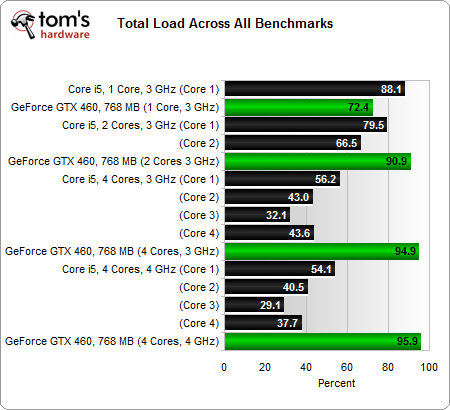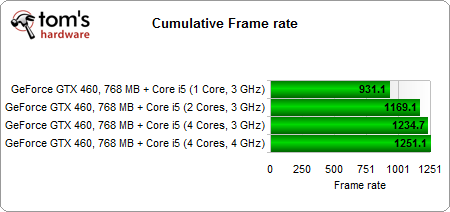The Game Rundown: Finding CPU/GPU Bottlenecks, Part 2
We're back with Part 2 of our bottleneck exploration in a mainstream gaming PC equipped with a Core i5 and GeForce GTX 460, ready to dive into test results from ten additional games. All of the results are summarized and analyzed in our conclusion.
Total Utilization Analysis
Since our 20 games are very different when it comes to CPU/GPU utilization and dependency, we have to be very cautious when drawing any conclusions. No single answer can be applied to all games.
Take Alien vs. Predator as an example. You can easily play it with a weak CPU and a strong graphics card. But using Grand Theft Auto 4 EFLC with a setup like that would severely limit frame rates, since it's so CPU-heavy. And while budget hardware can hit more than 60 FPS in old games without breaking a sweat, the DirectX 11-class Metro 2033 and S.T.A.L.K.E.R. titles are unplayable without a good graphics card.
There are a few things you can take away from these graphs. Even if a single-core CPU is only 88% utilized, you are still missing out on about 30% of your potential graphics card performance. With a dual-core CPU, the untapped potential is just 9%, and a quad-core CPU can bring this number down to around 5%. It's important to note that multi-core CPUs decrease the jerky gameplay you might suffer on a single-core system when games need to load new resources. In any case, all four cores are very rarely fully used, leaving software with some breathing room.
In this overview, all results from the different benchmarks are added up without weighting. All values are in frames per second. We decided to not convert them to percentages, since the results tend to point towards dual-core CPUs, although most new purchases will likely be CPUs with at least three or four cores. As you can see, the performance gains from overclocking the CPU are almost non-existent at these high graphic quality settings, the 1920x1200 resolution, and with a GeForce GTX 460.
Get Tom's Hardware's best news and in-depth reviews, straight to your inbox.
-
nativeson8803 It's disappointing to see that devs still aren't taking advantage of multiple cores like they could.Reply -
KingArcher Would there be any performance difference between windows 7 32bit and 64bit?Reply
Assuming you use the same amount of RAM . -
slayvus Great run down guys. I would of liked to see a three core benchmark thrown in there, but what can you expect from a dual core with HT.Reply
@KingArcher Unless the program was designed for x64, you had more than 4GB of unused RAM that the game could use and could use more than 4GB I highly doubt whether or not your on x86 or x64 would matter.
@nativeson8803 What difference would it make on games that are still GPU limited at two cores? Even then, there were games limited by the GPU at four cores. Taking advantage of a CPU with four cores or more is going to be hard when you need more GPU to get more frame rates. -
palladin9479 @Slayvus almost true. The difference would be @2 GB of available memory. NT x86 kernel only allows an application to access 2GB of address space with the other 2GB reserved for kernel use. In NT x86 world each application can only access 2GB of memory, with the application getting rather unstable once it goes over 1.8 GB. This limitation also applies to the NT x64 kernel running a 32-bit problem through WOW64. Its something left over from the NT 4.0 / 5.0 world.Reply -
archange Just keep in mind that these result are relevant in the context of using the GTX 460 768 MB, which is the real bottleneck here. Better GPUs and/or multi GPU setups would shift the bottleneck towards the CPU.Reply
In the end, it's all about finding the perfect balance in hardware. If you want my advice, pair the GTX 460 768 MB with a fast dual core, but get a good quad with higher end model GPUs. -
I'd like to see them test the first Supreme Commander.Reply
It still taxes the most powerful systems -
They should have used Phenom II X6 and test with 1/2/3/4/6 cores enabled. This made me want more of this because there aren't any 6-core benchmarks.Reply
Make a Part 3. -
lashabane archangeJust keep in mind that these result are relevant in the context of using the GTX 460 768 MB, which is the real bottleneck here. Better GPUs and/or multi GPU setups would shift the bottleneck towards the CPU.In the end, it's all about finding the perfect balance in hardware. If you want my advice, pair the GTX 460 768 MB with a fast dual core, but get a good quad with higher end model GPUs.I totally agree with archange. I understand that you're trying to go for the "norm", but if you're looking for bottlenecks, you need to remove said bottlenecks to see where it truly lays. Start with a quad core clocked at ~3.5ghz and swap out gfx from there. Push and push to see where it truly lays instead of going for a baseline. Although you can use that baseline to see what the "average" person might use. If the article is truly about the bottleneck, use something beefier than the 460.Reply

